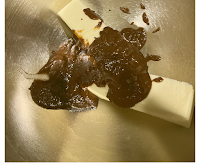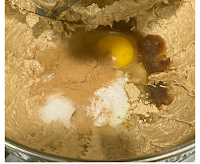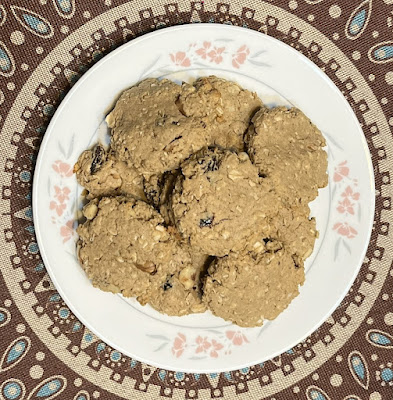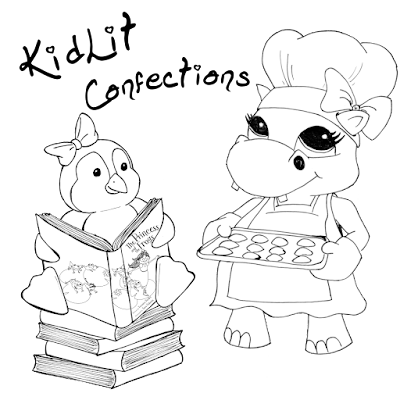
(The recipes, including a link to the index of printable PDF files, can be found at the bottom of this post.)
We often think about things that are "different" as bad, unsavory, or at least unpleasant. When we see something unfamiliar on the table for dinner, it's common to think "I'm not going to like that." And when the new kid in school dresses differently or has a funny haircut, we might wonder if they'll fit in with our friends...
These days, I'm pretty good at keeping an open mind, because most of my very favorite things in the world are things that were "different" when I first encountered them. (This of course includes most of my favorite people!) But I still sometimes have to remind myself that "different" isn't a bad word.
Especially when I feel like I am the one who is "different." When it feels like everyone else knows "the rules" and I'm stuck on the sidelines, wondering why no one taught me how to play the game. When I can't figure out the right words to say or the right clothes to wear or the right...anything, and I worry that I'll never quite "fit."
That's how I've felt my whole life, until last year when I was diagnosed as autistic. Suddenly, the whole world made sense! I wasn't broken. I wasn't defective. I was just Different. And that's a good thing.
One of my new favorite books is GOOD DIFFERENT by Meg Eden Kuyatt. (And my love for the story is completely justified. I just discovered that GOOD DIFFERENT is a Schneider Family Book Awards middle-grade honor book!)
Selah knows her rules for being normal.She always, always sticks to them. This means keeping her feelings locked tightly inside, despite the way they build up inside her as each school day goes on, so that she has to run to the bathroom and hide in the stall until she can calm down. So that she has to tear off her normal-person mask the second she gets home from school, and listen to her favorite pop song on repeat, trying to recharge. Selah feels like a dragon stuck in a world of humans, but she knows how to hide it.Until the day she explodes and hits a fellow student.Selah's friends pull away from her, her school threatens expulsion, and her comfortable, familiar world starts to crumble.But as Selah starts to figure out more about who she is, she comes to understand that different doesn't mean damaged. Can she get her school to understand that, too, before it's too late?
This is a book I wish I'd had when I was growing up. I didn't know anything about autism. I had never even heard the word. I absolutely didn't know it was my word. If I had been able to see myself reflected in the books I was voraciously devouring from the library every week, maybe I would have been able to see that "different" is not a bad word. Yes, I was different from many of the kids in my class. I saw things from a different perspective. I processed information through a different lens. I had different reactions to various stimuli. There's no denying that I was in fact different. And like Selah, I tried so hard to follow the "rules" for being "normal," with often frustrating results. I wish I could have known that Different can be a very good thing.
This is why we need diverse books. (side note: Because the theme for this week's KidLit Confections post is so similar to the last one, I'm going to stick with the password WeNeedDiverseBooks for printing the PDF versions of the Kid Lit Confections recipes!) We need to see the world reflected through all kinds of lenses. Not just the "normal" point of view from a white, cis, able-bodied, neurotypical perspective. Children (and adults!) of all types deserve the opportunity to see their perspectives reflected as Good Different. And even more, we need the opportunities to visit the perspectives of those who experience the world differently, so that we can better understand each other. That's why it's so important to not only have books that populate their fictional worlds with diverse characters, but those that are written (and illustrated) by folks who share those Different perspectives. Meg Eden Kuyatt is an autistic author. She understands what it's like to see the world through this lens. She knows what it means to be this particular kind of "Good Different," so her portrayal of Selah's story rings true in a way that those who haven't experienced it wouldn't be able to quite pinpoint.
Another amazing book I've read and loved recently is the picture book SAME LOVE, DIFFERENT HUG by Sarah Hovorka and Abbey Bryant
We like hugs big or small,
squeeze-me-tight or feathery light.
Bear hugs, morning hugs, jump hugs, too.
Quiet, loud; they all feel right.
But . . .
What do others like?
Some people love a big, strong hug. Others like a gentle hug. Some don’t like to hug at all—they like to shake hands instead. Same Love, Different Hug is a gentle picture book that looks at how different people connect and navigate boundaries, modeling social-emotional skills for the youngest among us.
This is another book that I wish I'd had years ago. It's such a perfect way to explain to young readers (and adults--and everyone in between!) that everyone has different comfort levels with physical affection. Sometimes because of personality differences, sometimes because of disability reasons, and sometimes because we simply need some space (or a giant cuddle) at the moment. Paying attention to the ways our friends, family members, and others want and need affection is one of the best ways to show genuine love and care.
I read this book through the lens of someone with autism, who sometimes gets overwhelmed by too much sensory input (and can't handle being touched) but sometimes needs the weight and pressure of a tight "squish hug" to reset my senses. And also through the lens of someone with a brain tumor that can cause all kinds of issues with my sensory inputs as signals get crossed on the way between my brain and the rest of my body. Sometimes, I want a squeeze-me-tight hug to know I'm not alone (or because my brain has literally forgotten how to breathe, and a tight hug can trigger the signal to remind me how to use my lungs). Sometimes even a feathery light hug is too much--sometimes even so painful that it makes me want to cry. It took me years to figure out how to express this to my family so that they could offer the right kind of hugs. And sometimes, I'm still too shy to ask for the hugs I need, because I'm afraid I might come across as either too demanding or too stand-offish. Books like SAME LOVE, DIFFERENT HUG make it easier to communicate to others that we all need different things from each other sometimes.
The author, Sarah Hovorka, mentions in the bio on her website that she deals with Crohn's Disease, and on the jacket flap of the book, it says that this partly inspired SAME LOVE, DIFFERENT HUG. We have different reasons for connecting to this particular story, but the connection is there. This is another reason we need diversity on our library shelves. Because it's not something I experience, I wouldn't necessarily pick up a book about (or created by someone who has) Crohn's Disease expecting to find a perspective relevant to my own. But the struggles (at least in this case) are similar, and this book helped me to find simple words to help explain my needs to friends and family members who haven't experienced anything like it themselves.
Next up on my To Be Read list: THE LOTUS FLOWER CHAMPION by by mother-daughter authors Pintip Dunn and Love Dunn
The main character in this book has OCD, just like the co-author Love Dunn. This is another kind of Different that has been unfairly stigmatized for years. And it's another kind of Different that I am exploring for myself. (My therapist is pretty sure I have it, but I'm waiting for an appointment with a psychiatrist to officially confirm the diagnosis. Because even though I firmly believe that self-diagnosis is perfectly valid in cases of neurodivergence, when most of the diagnostic criteria and assessments were written by neurotypical folks who don't fully understand the way our brains work...and even though I strongly suspect that my therapist is right, because I have so many "OCD Tendancies" that it definitely points to a diagnosis...I still need the "official" confirmation before my brain will let me claim it. Maybe that's a symptom of my OCD craving the completion of getting everything "right...")No escape. Follow the rules. And don’t count on reality―in this uniquely vibrant romantasy from NYT bestselling author Pintip Dunn and daughter Love Dunn…
It looks like paradise…only it’s not. This was supposed to be a once-in-a-lifetime family trip to Thailand. One last wish for my dying mama. Instead, we’re stranded on a lush, stunning island with ten strangers―held captive as Thai mythology unfolds around us…and within us.
Now we’re being tested. We’re expected to face our greatest fears―and possible deaths―in hopes of awakening some kind of dormant gift…or curse. One by one, we’re transforming, echoing the strange and sometimes wondrous abilities found in Thai folktales.
But my mama has only days to live, my papa is missing, and I’m forced to trust a group of strangers…including our evasive, dark-eyed tour guide, who resembles a minor god. Toss me in the ocean and feed me to the naga now.
Only I’m no hero. My days are managed by numbers and the compulsions that used to keep me safe.
I have to prove how far I can go. To survive. To protect my family.
And to find a way off this perilous island where everything is a lie…including reality.
“Good Different” Oatmeal Cookies

1 c. raisins
¼ c. water
1 c. butter
½ c. peanut butter (optional)**
2 eggs
1 tsp. baking soda
½ tsp. salt
½ tsp. ground ginger (optional)
1 tsp. cinnamon
2 tsp. vanilla extract
3 c. gluten-free oat flour
2 c. gluten-free oats

 Add eggs, baking soda, salt, ginger, cinnamon, and vanilla. Mix until combined, then turn speed up to high and beat until light and fluffy (3-5 minutes).
Add eggs, baking soda, salt, ginger, cinnamon, and vanilla. Mix until combined, then turn speed up to high and beat until light and fluffy (3-5 minutes). Mix in flour. Reduce mixer speed to low and add oats. Then,
stir in 1 ¼ to 1 ½ c. of your favorite mix-ins. I used 1 c. walnuts and ¼ c.
raisins. Or try: dried blueberries, chocolate chips, sunflower seeds, pecans, chopped
dried apples, M&Ms…whatever you like best!
Mix in flour. Reduce mixer speed to low and add oats. Then,
stir in 1 ¼ to 1 ½ c. of your favorite mix-ins. I used 1 c. walnuts and ¼ c.
raisins. Or try: dried blueberries, chocolate chips, sunflower seeds, pecans, chopped
dried apples, M&Ms…whatever you like best! Roll into 1-inch balls. Place on parchment-lined baking
sheet about 2 inches apart, and press to flatten each cookie slightly.
Roll into 1-inch balls. Place on parchment-lined baking
sheet about 2 inches apart, and press to flatten each cookie slightly. Makes about 5 ½ dozen cookies.
*Optional: Bake a few cookies & freeze the extra cookie dough. Roll
dough balls and flatten slightly. Place cookies on parchment-lined baking sheet
(no space necessary) and freeze for 2-4 hours. Once frozen, transfer cookie
dough to a large freezer bag and return to your freezer. You can bake straight
from frozen at 350 degrees Fahrenheit for 12-14 minutes. Freshly-baked cookies
anytime you want!
**If you choose to omit the
peanut butter, you may need to add 1 c. oat flour with the eggs in order to
achieve the right emulsification to get the light, fluffy texture to the batter
before adding the rest of the flour, oats, and mix-ins.









